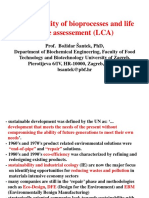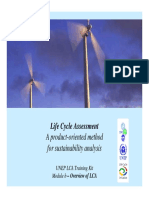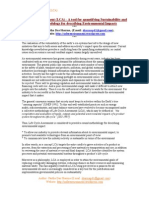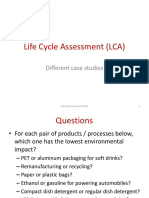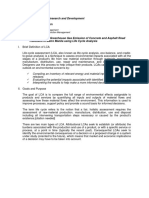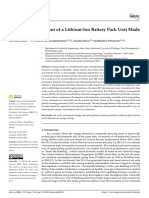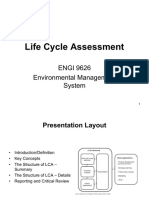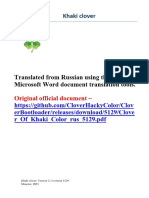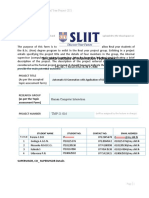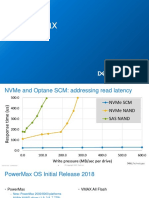U4-E3-1
This element teaches the fundamental notions of Life Cycle Assessment (named LCA).
This assessment method is a key facilitator of sustainability management in all businesses.
Performing a LCA is a method that requires several competencies, such as the ability to think
in a holistic manner when considering sustainability for a product or service.
You will see that this method is composed of several steps that relies on the “life cycle
thinking” paradigm. There are qualitative and quantitative approaches to performing LCA,
and results are mainly expressed through specific environmental impact indicators.
For instance, the well known “carbon footprint” indicator…
U4-E3-2
�… This «carbon footprint indicator » is responsible for the global warming potential impact
that is having an impact on our planet’s climate.
The carbon footprint is at the centre of the debate regarding electric vehicles. We all agree
that the gaz and petrol combustion during the use stage of a car generates an important
amount of carbon dioxyde (called CO2) emissions that could be potentially reduced in the
case of using an electric vehicle. But are we totally sure that the production and related
infrastructure, distribution and storage of electricity, are generating less CO2 emission than
the equivalent power deliverd by combustion engine? And if this is the case, how can we
make sure that while reducing CO2 emissions with electric cars, we are not increasing other
pollutions, nor accelerating the depletion of rare metals used in batteries for instance ((under
the environmental impact indicator called the abiotic depletion)).
U4-E3-3
�This is the main reason why LCA would be required: to have a multi-impact and multi-stage
environmental assessment of the product or service, for instance a car, considered through
every stage of its life cycle: from the extraction of raw material, to its end-of-life. This life
cycle assessment would provide visibility on the potential environmental impact transfer
from one stage to another or from one category of impact to another.
Considering the electric car, some battery and electronics are manufactured at the beginning
of the car life cycle, and specific treatments at the end of life stage would be necessary.
During the use stage, the associate emissions will depend on the type of electricity
production: is electricity produced from coal combustion, natural gas, renewable energy, …?
We see that this depends on the country where the car will be used.
U4-E3-4
�In France for instance, electricity power comes mainly from nuclear energy, whereas in
China, electricity is mainly produced from coal, which has a much higher carbon footprint.
The compilation of all material and energy flows from every stage of the life cycle of an
electric car compared to a petrol car, performed in different countries, shows that
Petrol car in France generates approximately 145g of CO2 per kilometer, while the electric
car generates in France around 38g of CO2 per km (more than 3 time less). Therefore, using
an electric car would be more environmentally friendly than a petrol car in France, if we only
consider carbon footprint.
Now in Europe, as an average (and considering the electricity mix of european countries), the
electric car generates approximately 126g per km, and in Asia, twice more. So compared to
using a petrol car, using an electric car would be less “environmentally friendly” in terms of
CO2 emissions in Asia than in France…
This quick example shows that performing a LCA is particularly relevant when comparing two
different scenarios of products that share the same function. This example also shows the
necessity to have an holistic view, and to adopt the “life cycle” vision.
U4-E3-5
�This life cycle vision is the heart centre of the life cycle assessment.
There is a high number of activity to consider for one or more product, composed of
components, sub-components, refill, recovering stage, (etc.) and various activities to take
into account from the extraction of raw material to the end of life to provide a given unit of
function(for instance delivering 100 km per week for 10 years). Each activity involved has a
number of inputs and outputs composed of primary material and energy flows. Each of those
would generate a potential environmental impact.
U4-E3-6
�Therefore LCA stands on two major principles:
• The life cycle vision that considers each stage of the life cycle of a product: the extraction
of raw material, the transformation of material into sub-components, the assembly of
those components into a product, its packaging, the use of this product or the service
delivered by the product, the possible refill or reparation of this product, the stage of
dismentling and recovery of the product, which can involve reusing some components,
recycling some material, incinerating, or landfilling parts or the totallity of the product.
Additionnally transport stages can occur between each of those life cycle stage. We see
here that it is fundamental to define the system boundary of each LCA study., and that
each LCA will state a number of assumption about included and excluded activities. Each
assumption will be carefully documented to allow reproductability of the LCA.
• The second principle LCA stands on is the multi-criteria reasoning. Several indicators will
be considered to assess the potential damage that would generate a product, for instance
global and local impacts on the environment (air, water and soil), and on human health.
U4-E3-7
�This table can be used to symbolise those two major priciples: on the X axis: the impact
categories and on the Y axis, the life cycle stages.
U4-E3-8
�The « so-called » carbon footprint is based only one impact category – the carbon equivalent
emissions – and takes into account all the product life cycle stages. It is therfore a mono-
impact Life Cycle Assessment.
U4-E3-9
�Using the same framework alternative approach would consider specific impact indicators for
specific life cycle stage. This is the case for exemple when assessing the energy consumption
during the manufacturing stage; or the recycling rate at the end of life, or again the
greenhouse gas emission for a product transportation.
U4-E3-10
�LCA is covering the various life cycle stage of a product or service and assessing the potential
impact generated by this product or service on a wide range of indicators that are aligned
with the goal and scope of the study.
U4-E3-11
�There are many interests in performing a LCA!
in terms of choosen topic it is possible to conduct a LCA on a majority of subject to help
investigate some critical questions. For instance age-old ones such as the environmental
analysis comparaison of disposal nappies versus cotton re-usable nappies, or electric versus
disposable shaver. And potentially it would be possible to compare chicken versus tofu in
term of environmental impact generated for a given portion of protein. Other questions are
more tricky, such as the environmental impact generated by raising a dog versus a cat… It
depends on the functional unit shared by those two animals.
It is indeed possible to compare anything, as long as they share what is called the functional
unit, and that the scope of the study is similar.
U4-E3-12
�And for a business conducting LCA on a regular basis can bring insight to foster a sustainable
strategy. For managers assessing the product life cycle can support investigation on a specific
technology for instance, and support decision making on a medium term basis. LCA results
can also be used to quantifying the added value of one design choice on the other during the
design process.
A business can choose to publish LCA of a given product to bring more transparency to the
public and the society about the product proposed.
This practice encourage a continuous learning improvement of any external and internal
stake related to the given product or service. Bringing detailled information about a given
product potentiel impacts toward its life cycle will can play an important role on a political
level of the society.
U4-E3-13
�In practice, performing a LCA is a standardized methodology. The ISO 14040 defines 4 general
steps: the goal and scope definition, the inventory analysis, the impact assessment and the
interpretation stages. The practitioner goes back and forth to one stage to another. For
instance, the impact assessment stage refers to the inventory analysis, and to the goal and
scope definition. Some lacking inventory data can also be revealed at this stage, and it may
require more investigation to complete the inventory to accurately cover scope of the study.
U4-E3-14
�The first step is the goal and scope definition.
U4-E3-15
�This is a key step and the ISO standards require that the goal and scope of an LCA be clearly
defined and consistent with the intended application. The goal and scope document
therefore includes technical details that guide subsequent work:
• The goal should include: The Reason why the LCA shall be conducted, the intended
application, and audience. For a business, the intended audience could be the product
manager or a client for instance.
• The goal should also include whether the results are intended to be used in comparative
assertions intended to be disclosed to the public. Specific considerations applies for
public disclosure, in particular LCA must be peer reviewed by an external expert.
The scope should include:
• The functional unit.
• The system boundaries; justifying the included and excluded activities.
• Any assumptions and limitations.
• The impact categories chosen.
• The allocation methods used to partition the environmental load of a process when
several products or functions share the same process.
• Type of critical review.
U4-E3-16
�The functional unit is based on the service provided by the product/system, and focuses on main functionalities
The functional unit allows the comparison between several products/solution that provide the targeted service.
A well defined functional unit shall contain the following elements:
• A verb at infinitive (for service provided).
• A technical criteria (that qualifies the performance of the system).
• An operating time (for whole life-cycle).
The Function, functional unit and reference flows are defined in the ISO 14040:2006 (in the paragraph 5.2.2) by the followings:
A system may have a number of possible functions and the one(s) selected for a study depend(s) on the goal
and scope of the LCA.
The functional unit defines the quantification of the identified functions (performance characteristics) of the
product. The primary purpose of a functional unit is to provide a reference to which the inputs and outputs are
related. This reference is necessary to ensure comparability of LCA results. Comparability of LCA results is
particularly critical when different systems are being assessed, to ensure that such comparisons are made on
a common basis.
It is important to determine the reference flow in each product system, in order to fulfil the intended function,
In other words, the amount of products needed to fulfil the function.
For example:
In the function of drying hands, both a paper towel and an air-dryer system are studied. The selected
functional unit may be expressed in terms of the identical number of pairs of hands dried for both systems. For each
system, it is possible to determine the reference flow, e.g. the average mass of paper or the average volume of hot air
required for one pair of hand-dry, respectively. For both systems, it is possible to compile an inventory of inputs and
outputs on the basis of the reference flows. At its simplest level, in the case of paper towel, this would be related to the
paper consumed. In the case of the air-dryer, this would be related to the mass of hot air needed to dry the hands.
U4-E3-17
�To give you an example, let’s consider the functional unit of paint. It could be defined as “to
cover one square meter for 10 years”.
In the first scenario, impacts of 1kg of paint A are 2 times bigger than 1kg of paint B.
But if If paint A covers 2 times better than paint B, then for covering the same surface you
must double the quantity of paint B.
And if paint A has a life time 2 times longer than paint B, then for covering the same surface
for the same life time you must use again the double quantity of paint B.
Those three scenario shows that considering one functional unit, the property of the product
under study makes the amount of reference flows varying.
U4-E3-18
�Another aspect to define in the goal and scope is the boundary of the study. It can be defined
by all activity included and in particular the excluded activities from the study. In order to
compare 2 systems orsolutions they must have the same boundaries.
U4-E3-19
�The second step of the LCA is the inventory analysis.
U4-E3-20
�Let’s take the exemple of a white board pen. A description of the amount of each material
and energy flow required to produced this pen, to pack it, to sell it, to use it (if any) and to
ensure its recovery is needed.
What are the main components of this product and which data are necessary to describe the
amount of material and energy?
U4-E3-21
�As we can see on the left side figure, each square refers to one process or activity involved in
the life-cycle of this pen. Of course this is an example, and the system boundary of this case
study is voluntarily limited.
Now let’s consider specifically how the ethanol contained in the ink is produced. In this
example it mainly comes from the production of sugar, which also has its own life cycle stage
with a high number of material and energy flows as well, as presented in the right side figure.
Similarly it would be necessary to investigate each life cycle of each sub-system involved in
the pen life-cycle.
U4-E3-22
�This is the reason why LCA are based on existing databases that are regularly updated by
experts and practitioners. The life cycle inventory is a complilation of all the raw material and
resources and all the emissions to air, water and soil from all the activities or systems
included in the system boundary of the study.
U4-E3-23
�The pen lid for instance, if produced by injection molding, will be the combination of a certain
quantity of material (refering to a specific material database) and the injection modlding
process adapted for this type of material (can be selected in a process database).
U4-E3-24
�The third step of LCA is the impact assessment.
U4-E3-25
�Basically from the previous stage calculation methods are used to translate the
amount of primary flows into impact category score. For instance the global warming
potential, the ozone depletion, the land use.
U4-E3-26
�Those calculation methods use different factors. For instance, a molecule of methane has
a global warming potential 25 more important than a CO2 molecule.
U4-E3-27
�As we can see the impact indicators are adapted metrics to assess a product. Incandescente
lamps will be compared to fluorescent lamps in terms of climate change potential, ecotoxicit,
etc. However, those metrics will not be adapted to measure the happiness rate of the user of
the lamps!
It is therefore important to aligne the goal and scope of the study to the type of impact
assessment mehod available for the product under study.
U4-E3-28
�The fourth stage of the LCA is the results interpretation.
U4-E3-29
�LCA results might show :
The Most impacting components.
The Most impacting lifecycle stages.
The Benefits of the chosen strategies, or product scenario (for instance a specific design, an
end-of-life scenario).
And the Benefits of the potential end-of-life strategies chosen in the study.
The graph shows the LCA results of a bench, where each color refers to one life cycle stage.
The value is given in the Y axis, and the X axis describes the various environmental impact
indicator chosen in this LCA.
U4-E3-30
�Interpreting the results of the LCA consists in trying to answer to the question of « Is
System A better than System B ? » for the specified audience of the study ?
To do so, the goal and scope of the study should be reinvestigated. In some case,
sensitivity analysis would be required, in particular when some determinant results
are mainly caused by a system relying on high uncertainty data. Specific technics
based on statistics are commonly used to conduct uncertainty and sensitivity
analysis.
The stage of result interpretation is also the opportunity for any internal or external
critical review.
As presented at the beginning of the presentation, LCA is a holistic approach. One
product is rarely better than its compared product on each impact indicator chosen
and regarding each stage of the life cycle included in the system boundary.
Interpreting results is therefore presenting results in the best manner to give a
scientific advice on the environmental performance of the studied system.
Recommendations can be elaborated at the end of the LCA. Some issues will be
addressed to the audience for them to take the best decision.
U4-E3-31
�In conclusion, LCA is adapted to industries that require quantitative results to scientifically
address the environmental impacts of their products or services. If required, full and detailed
LCA shall be performed by external LCA expert. Expert LCA software would be necessary to
conduct such a LCA.
LCA results are particularly relevant for product designers that want to investigate the
environmental performance of a product to improve its environmental performance.
As a multi-criteria and multi stage analysis, LCA is a consistent method to communicate to
stakeholders, for instance to clients, suppliers, consumers, NGOs…
U4-E3-32
�U5-E3-33
�U5-E3-34
�U4-E3-35










